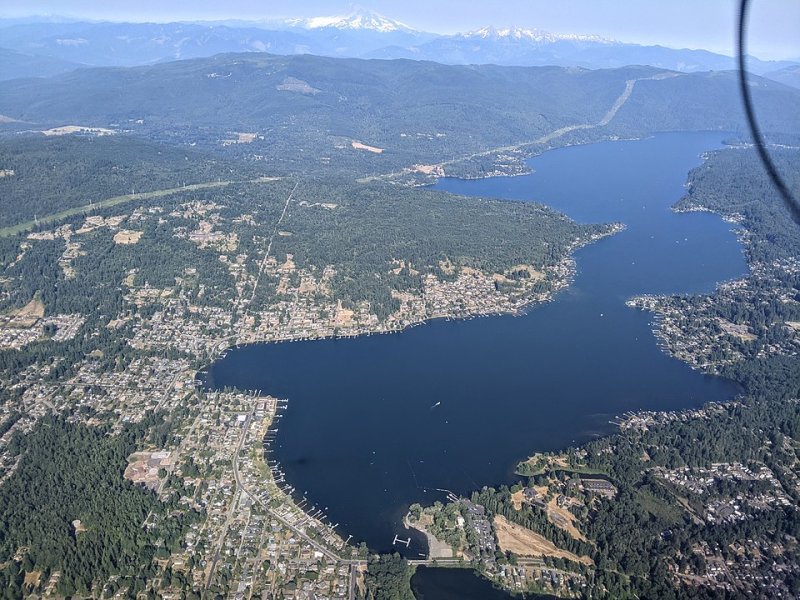CENV faculty have new research published on a variety of important topics
Faculty at Western's College of the Environment have been hard at work on their research, publishing a slew of new work, from the importance of scientific collaborations with Indigenous communities to an analysis of how noncentralized carbon-reduction efforts are impacting climate change.
Boundary Spanners
A new paper co-authored by WWU Associate Professor of Environmental Science Marco Hatch examines the under-recognized but critical role of the "boundary spanner." A boundary spanner is a person or team that facilitates partnerships between mainstream science and Indigenous communities. The Ecology and Society Journal article begins with a metaphor about baking by Skye Augustine from the Stz’uminus First Nation that deftly illustrates collaboration, partnership, and equity. It goes on to explain boundary work and presents a framework for true inclusion.
https://ecologyandsociety.org/vol28/iss1/art41/
Lake Whatcom Water Quality
Lake Whatcom is the primary source of drinking water for the City of Bellingham and parts of Whatcom County. Water quality can be adversely affected by many factors, including the existence of bacteria and excess nutrients. While the City of Bellingham tests and treats drinking water as it travels through the system, they’ve partnered with WWU to provide independent Lake Whatcom water quality monitoring for decades. Western’s Institute for Watershed Studies (IWS) just released its yearly report looking at long-term water quality trends in the lake and tributaries. IWS Director Angela Strecker presented the annual Lake Whatcom water quality report to the Bellingham City Council at the Wednesday, March 29 Lake Whatcom Joint Councils and Commissioners Meeting.
https://cedar.wwu.edu/lakewhat_annualreps/31/
Feeding university students in precarious times
How can universities better support hungry students? A new article in the Journal of Agriculture, Food Systems, and Community Development, titled “From food access to food sovereignty, authors Kate J. Darby, Lena Hemmer, Renee Holt, Terri Kempton, Melanie del Rosario, Jon Stubblefield, and Grey Webster present relevant findings from a study designed to understand the contours of food insecurity among college students at Western Washington University, a public university in the Pacific Northwestern United States. This paper illustrates the need for campus-based food provisioning strategies that address the precarity faced by all college students, as well as those that specifically prioritize BIPOC students and others with marginalized identities.
https://www.foodsystemsjournal.org/index.php/fsj/article/view/1145
Polycentric governance
Climate change is a complex, global problem, and logic holds that national and international regulation is necessary. In the U.S., federal policies on climate change are lacking, but hundreds of state and local governments and thousands of industrial facilities are leading the way by prioritizing decarbonization. Are these noncentralized actions helping? A recent paper in the journal Environmental Policy and Governance titled "Can polycentric governance lower industrial greenhouse gas emissions," co-authored by WWU Professor of Urban and Environmental Planning and Policy Troy Abel, examines whether and how much a polycentric approach can shape environmental outcomes.
https://onlinelibrary.wiley.com/doi/full/10.1002/eet.2051
Microscopic biota & plant invasions
Plants, much like humans, have communities of microscopic biota inside them. These biota can help or hinder plants, depending on environmental conditions. The paper "Soil moisture and competition determine soil biota effects on invasive Centaurea stoebe," recently published in the journal Functional Ecology, looks at fungi in the roots of spotted knapweed, a widespread invasive plant, and how these fungi shift from helpful to harmful when soil moisture increases. With the help of WWU students working in the greenhouse, Associate Professor of Environmental Science Rebecca Bunn and coauthors grew knapweed in wet and dry soil, with and without a neighboring native grass and with and without fungi in their roots. Results suggest that soil fungi may contribute to knapweed invasion in dry regions but hinder knapweed in wetter regions. Further examination of these interactions could help us understand and predict future plant invasions.
https://besjournals.onlinelibrary.wiley.com/doi/abs/10.1111/1365-2435.14295
